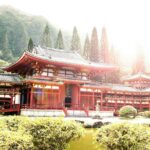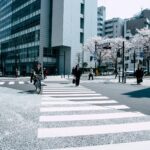Rakugo is a traditional Japanese art form that combines comedy and storytelling. It has been captivating audiences for centuries with its clever wit and immersive narratives.
In this article, we explore the origins, stories, and places where you can experience the magic of Rakugo.
Key Takeaways
- Rakugo is a traditional Japanese art form that combines comedy and storytelling. It can also evoke sentimental emotions, and each story ends with a punch line.
- It is performed by a single person on stage known as a rakugoka, who uses voice and body language to act out the story.
- There are two main types of rakugo in Japan: Kamigata Rakugo performed in Osaka and Kyoto, and Edo Rakugo performed in Tokyo.
- Rakugo performances are typically held in traditional theaters called yose, providing an authentic setting for audiences to enjoy the art form.
- For those interested in experiencing rakugo, there are venues in Tokyo such as Suzumoto Engeijo, Engei Hall, and Engeijo that offer regular performances.

Photo by Griffin Quinn on Unsplash
What Is Rakugo?
Rakugo (落語) is a popular form of storytelling in Japan. It’s performed by a single person on stage, known as a rakugoka.
The rakugoka or lone storyteller (落語家) takes on different characters and acts out the story using their voice and body language. They use pitch, tone, and gestures to signal the change between characters, creating an engaging and dynamic performance.
Each story ends with a punch line, also known as ochi (落ち, lit. “fall”) or sage (下げ, lit. “lowering”).
During a rakugo performance, the rakugoka sits on a small stage with only a sensu (folding fan) and tenugui (small cloth) as props.
Rakugo stories are usually humorous monologues that can also evoke sentimental emotions.
The success of a rakugo performance depends on the rakugoka’s skill in conveying the story through their voice and movements. It requires a deep understanding of the story, as well as impeccable timing and comedic delivery.
A well-executed rakugo performance can have the audience laughing one moment and deeply moved the next. It’s this unique blend of storytelling, physicality, and comedic talent that sets rakugo apart as a distinct form of Japanese entertainment.
Types of Rakugo
There are two main types of rakugo in Japan: the “Kamigata Rakugo” and the “Edo Rakugo”. The table below shows the differences between the two styles.
| Kamigata Rakugo | Edo Rakugo |
| Performed in Osaka and Kyoto. Kyoto style declined, so Osaka has been called Kamigata Rakugo Uses Kansai accent More flashy and lively | Performed in Tokyo (previously known as Edo) Uses standard langauge |
How Do You Become a Rakugo Storyteller?
To become a recognized professional rakugo storyteller, aspiring performers must complete an apprenticeship with a rakugo master, which can last up to three years.
During this rigorous apprenticeship, they learn the art of storytelling by watching and imitating their master’s performances, while also taking on various household chores and responsibilities.
History of Rakugo: The Origin of Traditional Japanese Storytelling
Rakugo has a rich history dating back to the Heian period, which began in the 9th century.
During this time, people already had a fondness for sharing humorous stories. Buddhist monks found an innovative way to captivate their audience by incorporating these tales into their sermons, making them more interesting and relatable.
Buddhist monks in the Heian period often quoted specific story collections to deliver the teachings of Buddha in an engaging manner.
However, it was during the subsequent Sengoku period that Buddhist monks were employed by powerful daimyō or feudal lords.
These lords recognized the importance of literature and the art of conversation and sought to enhance their knowledge in these areas.
One particular monk named Anrakuan Sakuden excelled in this role and wrote a collection of 1000 stories. Some of these stories would eventually lay the foundation for the art of rakugo.
The written tradition of rakugo can be traced back to the story collection called Uji Shui Monogatari, which was published between 1213 and 1218.
Over time, rakugo evolved from a narrative form into a monologue style. This shift likely occurred upon the request of feudal lords, who desired skilled entertainers capable of telling various stories for their amusement.
However, it was in the Edo period, which lasted from 1603 to 1867, that rakugo truly flourished and gained popularity among the lower classes. The emergence of the merchant class, known as the chonin, during this time contributed to the spreading of rakugo to wider audiences.
Many rakugo performers formed groups, and collections of rakugo texts were finally printed and made accessible to a broader audience.
In the late 18th century, Utei Enba sparked a rakugo revival in Edo (now Tokyo) and numerous performing groups emerged. This also marked the beginning of writing down rakugo stories, ensuring their enjoyment for future generations.
During this revival period, performances took place in major cities like Edo, Osaka, and Kyoto. While the Edo and Osaka traditions have endured, the Kyoto style eventually faded away.
Today, rakugo continues to captivate audiences with its unique blend of humor, storytelling, and performance.
Rakugo stories often depict everyday life situations in various settings, such as the daily struggles of workers or the concerns of kabuki actors. Some stories even playfully mock different Japanese dialects.
Rakugo Stories
Let’s take a closer look at some captivating examples of rakugo storytelling, a unique art form that has been passed down through generations in Japan.
One genre of rakugo that is used for introductory lessons is called Kobanashi (こばなし).
Here are the short stories in the genre:
- Nezumi (ねずみ): A story about a mouse and three opinions.
- Uekiya(うえきや): A story about a florist and a taunting customer.
- Bijutsukan (びじゅつかん): A story about a lady at the museum.
- Yopparai (よっぱらい): A story about a conversation gone drunk at an i-za-ka-ya.
Rakugo in English
Jugemu (寿限無/じゅげむ) is one of the most famous stories performed in rakugo. The plot is about a couple who can’t think of a name for their baby, so the father goes to a local temple to ask the priest for a name that can guarantee the child long life.
You can watch a performance of Jugemu in English in this Youtube video:
Where Can You Experience Rakugo?
If you’re interested in experiencing rakugo in person, there are several venues where you can enjoy this traditional Japanese art form.
Traditional theaters called yose have performances almost every day, providing an opportunity to witness the captivating storytelling firsthand.
In Tokyo, you can visit the Suzumoto Engeijo in Ueno, the Engei Hall in Asakusa, and the Engeijo in Ikebukuro.
These theaters offer an authentic setting where rakugo performers take the stage and showcase their incredible talent by delivering humorous stories that have been passed down through generations.
Conclusion
Whether you experience Rakugo live in Japan or through recorded performances, you’ll be able to witness the unique blend of comedy and narrative that makes this art form so special. It offers a glimpse into the rich cultural heritage and storytelling traditions of Japan.
Rakugo is a fascinating way to learn about Japanese culture and history. It allows you to immerse yourself in the traditional art of storytelling and experience the wit and humor that has been passed down through generations.
Whether you’re a fan of comedy or simply enjoy hearing engaging stories, Rakugo is sure to entertain and engage you.









